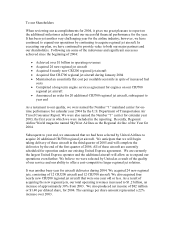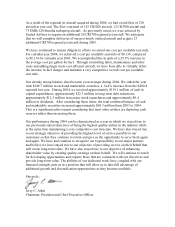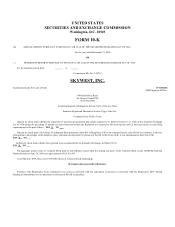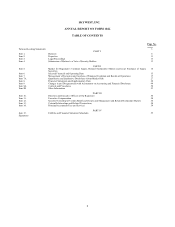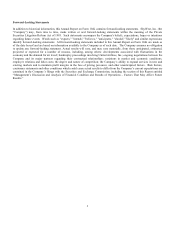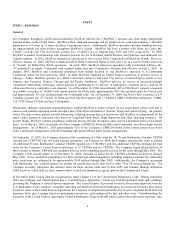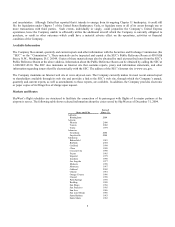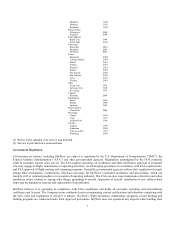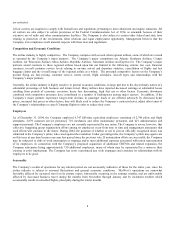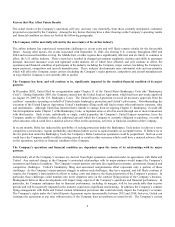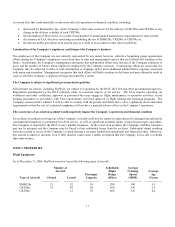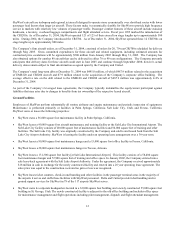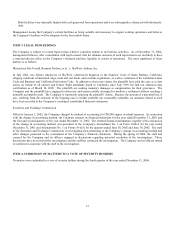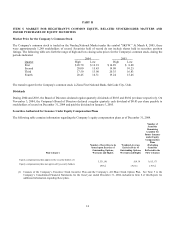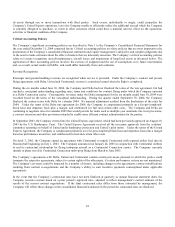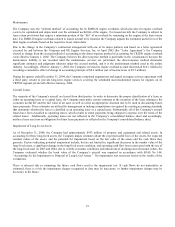SkyWest Airlines 2004 Annual Report Download - page 11
Download and view the complete annual report
Please find page 11 of the 2004 SkyWest Airlines annual report below. You can navigate through the pages in the report by either clicking on the pages listed below, or by using the keyword search tool below to find specific information within the annual report.9
Factors that May Affect Future Results
The actual results of the Company’s operations will vary, and may vary materially, from those currently anticipated, estimated,
projected or expected by the Company. Among the key factors that may have a direct bearing on the Company’s operating results
and financial condition are those set forth in the following paragraphs.
The Company will be materially affected by the uncertainty of the airline industry
The airline industry has experienced tremendous challenges in recent years and will likely remain volatile for the foreseeable
future. Among other factors, the events associated with September 11, 2001, the slowing U.S. economy throughout 2003 and
2004 and increased hostilities in Iraq, the Middle East or other regions have significantly affected, and are likely to continue to
affect, the U.S. airline industry. These events have resulted in changed government regulation, declines and shifts in passenger
demand, increased insurance costs and tightened credit markets, all of which have affected, and will continue to affect, the
operations and financial condition of participants in the industry including the Company, major carriers (including the Company’s
major partners), competitors and aircraft manufacturers. These industry developments raise substantial risks and uncertainties
which will affect the Company, major carriers (including the Company’s major partners), competitors and aircraft manufacturers
in ways that the Company is not currently able to predict.
The Company has been, and will continue to be, significantly impacted by the troubled financial condition of its major
partners
In December 2002, United filed for reorganization under Chapter 11 of the United States Bankruptcy Code (the “Bankruptcy
Code”). During September 2003, the Company entered into the United Express Agreement, which had been previously approved
on August 29, 2003 by the U.S. Bankruptcy Court. The United Express Agreement received all necessary approvals from the
creditors’ committee operating on behalf of United under bankruptcy protection and United’s pilot union. Notwithstanding the
execution of the United Express Agreement, United’s bankruptcy filing could still lead to many other unforeseen expenses, risks
and uncertainties. Although United has reported that it intends to emerge from its ongoing Chapter 11 bankruptcy, it could still
file for liquidation under Chapter 7 of the Bankruptcy Code, or liquidate some or all of its assets through one or more transactions
with third parties. Such events, individually or singly, could jeopardize the Company’s United Express operations, leave the
Company unable to efficiently utilize the additional aircraft which the Company is currently obligated to purchase, or result in
other outcomes which could have a material adverse effect on the operations, activities or financial condition of the Company.
In recent months, Delta has indicated the possibility of seeking protection under the Bankruptcy Code unless it achieves a more
competitive cost structure, regains profitability and obtains further access to capital markets on acceptable terms. If Delta were to
file for protection under the Bankruptcy Code, the Company’s Delta Connection operations could be jeopardized. Such an event
could leave the Company unable to utilize existing aircraft or result in other outcomes which could have a material adverse effect
on the operations, activities or financial condition of the Company.
The Company’s operations and financial condition are dependent upon the terms of its relationships with its major
partners
Substantially all of the Company’s revenues are derived from flight operations conducted under its agreements with Delta and
United. Any material change in the Company’s contractual relationships with its major partners would impact the Company’s
operations and financial condition. The Company’s major partners currently face significant economic, operational, financial and
competitive challenges. United’s bankruptcy filing and associated reorganization effort represents only a portion of those
challenges. As the Company’s major partners struggle to address such challenges, they have required, and will likely continue to
require, the Company’s participation in efforts to reduce costs and improve the financial position of the Company’s partners. In
particular, these challenges could translate into lower departure rates on the contract flying portion of the Company’s business.
Management believes these developments will impact many aspects of the Company’s operations and financial performance. In
particular, the Company anticipates that its financial performance, including its margins, will be less predictable than in prior
periods and will be negatively impacted as the industry experiences significant restructuring. In addition, the Company’s contract
flying arrangements with Delta and United contain termination provisions that could adversely impact the Company’s revenues.
The Company’s rights under the United Express Agreement expire incrementally between 2012 and 2016; however, United can
terminate the agreement at any time without notice if the Company does not perform at certain levels. The Company’s current

